Agroforestry, fertility and soil erosion in Africa
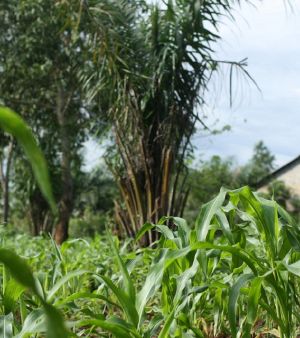
Agroforestry is a production system that integrates trees with crops, livestock, or both. It is suitable for many situations. Contrary to some beliefs, it can even be used on small areas in combination with crops. Because of its advantages, agroforestry can prove to be an alternative in areas where slash-and-burn cultivation is practiced[1].
Ecological scope and interests
According to the organizers of the 4th World Agroforestry Congress held in May 2019 in Montpellier, France, "agroforestry is a major innovation in contemporary agriculture and a key element of agroecological transition." Indeed, trees appear to bring many beneficial effects to agroecosystems:
Food and non-food biomass production
Agroforestry has been shown in many situations to be beneficial for producers in terms of food security and the supply of fuel, construction materials, and fodder[2].
Soil fertility
Trees contribute to the restoration of soil fertility, especially when trees from the legume family (Fabaceae) are used. Trees produce significant biomass that can enrich the soil through the accumulation of leaves and branches on the ground, as well as through exudates and the decomposition of their roots[3]. These biomass inputs provide a wide variety of nutrients to the soil, with only a lack of phosphorus noted[4]. If phosphorus deficiency occurs, it can be compensated for by bone meal or mycorrhizae (fungi) that thrive on woody materials (branches, wood chips, bark, etc.).
Protection against elements (sun, rain, and wind)
The canopy of trees, their roots, as well as the litter that forms around them, alter the microclimate and limit erosive meteorological effects. This helps to reduce the ground temperature and preserve water in the soil[5][6], thus extending the growing period of neighboring crops[7], for example. If trees and shrubs are used as windbreak barriers, it is important to arrange them so that the barrier remains permeable to filter the wind rather than deflect it. This way, the positive effect will be effective over a greater distance. Additionally, it is observed that the highest yields are obtained at a distance of approximately 3 to 7 times the height of the barrier[8].
Promotion of biodiversity
Through microclimate management and the addition of organic matter, trees foster life in the soil. The presence of earthworms (and other members of the macrofauna) in the soil, often used as indicators of biological activity, is strongly correlated with the presence and abundance of trees in tropical environments[9][10][11]. Agroforestry not only benefits soil biodiversity but also biodiversity as a whole, including birds, pollinating insects, etc[12].
Furthermore, introducing trees on farms helps reduce pressure on natural forests (for fuelwood, construction, etc.). It is important to remember that, as with crops, diversity in trees must be maintained. Plantations of a single tree species are susceptible to the same problems as monocultures of annual plants[13].
Nutrient uptake and prevention of leaching
Tree roots allow for the uptake of a large quantity of nutrients from deep layers of the soil and make them available to crops, especially surface nutrients that would otherwise leach away[14].
Atmospheric carbon sequestration
Trees play an important role in sequestering carbon in their biomass and in the soil, thus contributing to climate change mitigation[15][16][17].
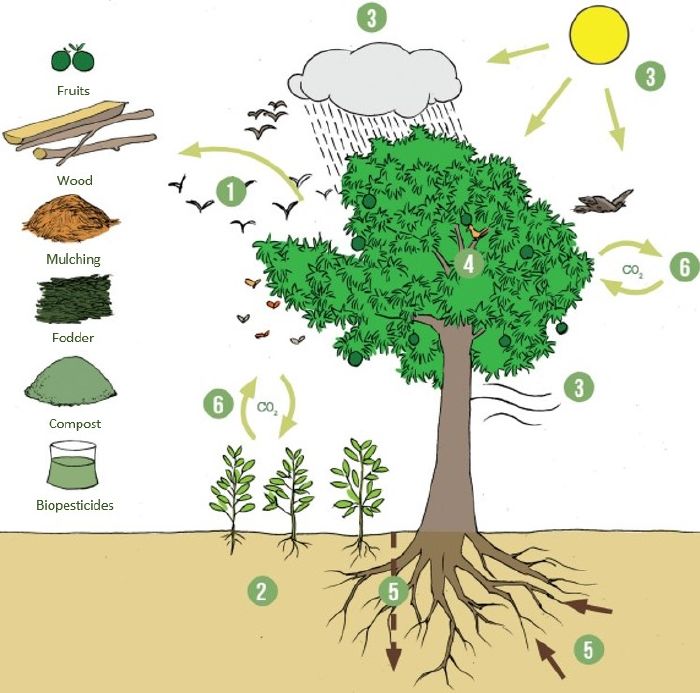
Implementation conditions
Firstly, it is important to determine which trees one wishes to plant and what their functions will be (food, fertilizing, etc.). Here, we will mainly focus on trees whose main roles are fertilization and restoration of degraded soils.
Potential trees and shrubs
- Faidherbia albida (formerly Acacia albida):
- Description: Large thorny tree of the Sahel, drought-resistant. Unlike most trees, it sheds its leaves in the rainy season and fixes nitrogen.
- Roles: Biomass production to improve soil fertility, fodder production, suitable for beekeeping.
- Senna siamea (Cassia):
- Description: Large tree native to Asia, drought-resistant.
- Roles: Fuelwood, nitrogen fixation, biomass production to improve soil fertility.
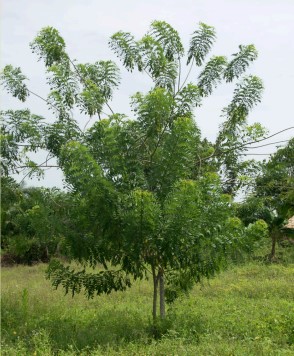
- Tephrosia vogelii:
- Description: Shrub native to tropical Africa, drought-resistant, toxic to most animals (except goats).
- Roles: Leaves with insecticidal effect, nitrogen fixation, biomass production to improve soil fertility.
- Cajanus cajan (Pigeon pea):
- Description: Shrub native to India.
- Roles: Peas for human consumption, nitrogen fixation, biomass production to improve soil fertility.
- Leucaena leucocephala:
- Description: Tree native to Central America, better suited for neutral or alkaline soils and low altitudes (<800 m).
- Roles: Animal fodder, fuelwood, nitrogen fixation, biomass production to improve soil fertility.
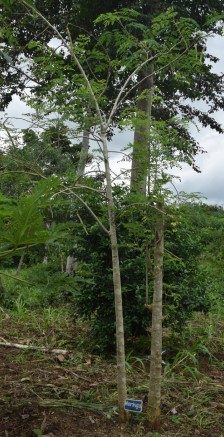
- Gliricidia sepium:
- Description: Tree native to South America, better suited for acidic soils.
- Roles: Exceptionally good fodder, fuelwood, leaves with insecticidal effect, nitrogen fixation, biomass production to improve soil fertility.
- Moringa oleifera:
- Description: Tree native to India.
- Roles: Leaves for human nutrition, biomass production to improve soil fertility.
- Neem (Azadirachta indica):
- Description: Tree likely native to India, drought-resistant.
- Roles: Effective erosion prevention, insecticidal effect, fuelwood, biomass production to improve soil fertility, medicinal properties, fodder (liked by goats), potentially invasive.

Necessary equipment
- Boots: Foot protection.
- Tillage Tools (hoe, machete, daba): Clearing the plot and soil preparation.
- Opaque plastic bags / clay pots: Nursery establishment.
- Sprayer: Application of biopesticides and liquid compost.
- Shovels: Handling compost.
- String line: Plot sizing and transplanting of young plants.
- Basins and wheelbarrows: Transporting plants, compost, water, etc.
- Watering cans: Watering the nursery and transplanted plants.
- Bags: Packaging compost.
Materials / Raw materials
- Seeds.
- Compost.
- Products based on fungi (Mycotri, Mycoplus).
- If necessary, neem-based biopesticides, chili, garlic, etc.
Mycoplus: Product based on fungi and waste of plant and animal origin. It is a foliar liquid fertilizer that stimulates plant growth. It is also believed to help plants better resist drought and diseases.
Mycotri and Mycoplus are products manufactured and available in Togo.
Planting
There are some prerequisites to be met before embarking on planting:
- Availability of a prepared space to set up the nursery and the farm.
- Necessary skills for practice.
- Availability of appropriate equipment and materials in sufficient quantity.
- Rigorous planning and organization.
- Availability of water.
- Availability of labor.
- Similar to crop associations and rotations in Africa, trees can be associated with crops in various arrangements.
Border planting
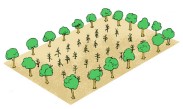
Trees surround the crops. This arrangement can be adapted, for example, to delineate pastures or protect crops from wind.
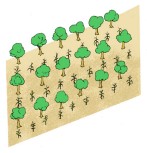
Alternate planting
Rows of trees are integrated between the crops. This arrangement can be used, for example, if the trees primarily serve as fertilizers or windbreaks, including when they are part of a rotation with crops.
Scattered planting
Trees are scattered within the crops. This arrangement can be used, for example, if the trees primarily serve a food function. To diversify the supply of organic matter, leguminous trees or shrubs can be used in addition to cover legumes such as [1] or [2].
Setup steps
- Prepare the terrain for the nursery (shaded, easily accessible, close to a water source, etc.).
- Sow tree seeds in bags containing a mixture of 1/3 compost, 2/3 soil, and Mycotri if available.
- Regularly maintain the seedlings (watering, weeding, and if necessary, application of Mycoplus).
- Choose and prepare the terrain according to the desired effect and available space (windbreak, shading, etc.).
- Dig holes for planting; if necessary, form a basin to collect water and organic matter using the Zaï technique.
- Plant the young seedlings and apply compost (and if available, Mycoplus).
- Maintain the field (application of biopesticides if necessary).
Maintenance
The tree should be pruned a few weeks before the beginning of the rainy season, and the biomass collected can be used as cover or superficially buried. If organic matter is deposited too early in the dry season, many of its benefits would be lost[18]. This biomass can also be used for composting, as fuel, or as fodder for animals.
Challenges and constraints
- The search for water for regular watering of young plants is a workload.
- The time it takes for the tree to grow and produce its benefits is quite long. If the tree does not provide tangible benefits to farmers, they may prefer to plant a cash crop.
- During the dry season, trees may suffer damage from animals.
Sources
Manuel des bonnes pratiques agroécologiques - SECAAR.
This page was written in partnership with the Urbane project and with the financial support of the European Union.
- ↑ Castro et al., 2009
- ↑ Mbow et al., 2014
- ↑ Kang et al., 1999
- ↑ C. A. Palm, 1995
- ↑ Lin, 2010
- ↑ Castro et al., 2009
- ↑ Bunch, 2012
- ↑ Gliessman, 2014
- ↑ Pauli et al., 2010, 2011
- ↑ Dangerfield, 1993
- ↑ Tian et al., 2000
- ↑ Bhagwat et al. 2008
- ↑ Sileshi et al., 2008
- ↑ Rowe et al., 1999
- ↑ Paustian et al., 2016
- ↑ Nair, Kumar, and Nair, 2009
- ↑ Hombegowda et al., 2016
- ↑ Bunch, 2012

